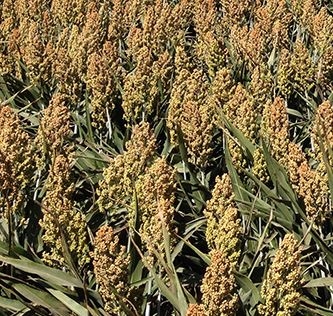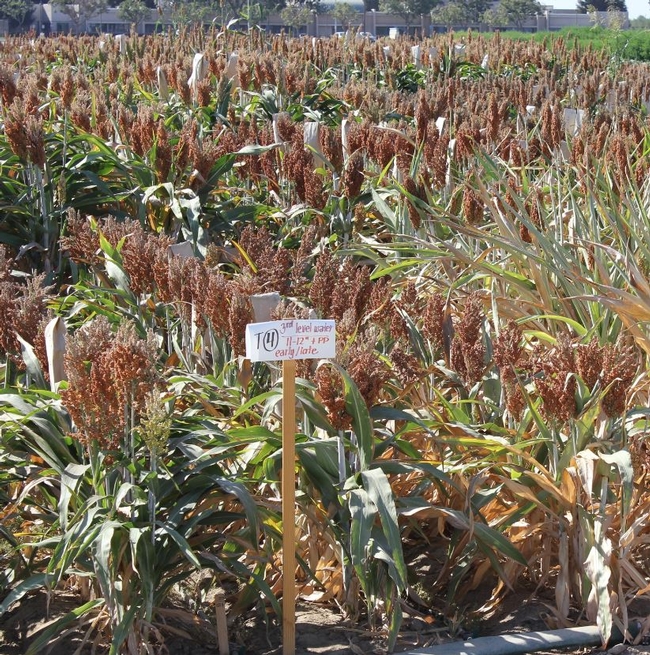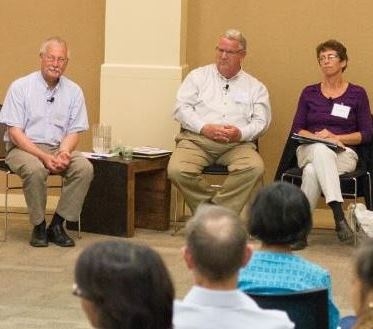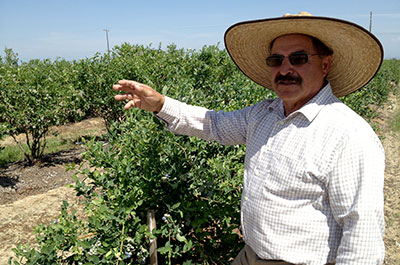- Author: Laura J. Van der Staay
An Op-Ed article written by Jeff Mitchell, CE Cropping Systems Specialist in vegetable cropping systems, irrigation management, soil quality, organic soil amendments, extension models, and postharvest physiology in the Department of Land, Air and Water Resources at UC Davis and at UC ANR Kearney Agricultural Research and Extension Center and Randy Southard, Professor and Soil Genesis/Morphologist in the Department of Land, Air and Water Resources at UC Davis was included in the October 30 issue of the Sacramento Bee. More information on conservation tillage practices can be found on the Conservation Agriculture Systems Innovation (CASI) website.

- Author: Laura J. Van der Staay
If you are interested in getting information regarding research on the use of sorghum as a multi-purpose low-input crop for California, please go to this link. Under the research link, there are some videos showing the harvest of experimental plots as well as the use of a drone to perform rapid, robotic phenotyping of sorghum for character traits such as plant height, leaf area, and biomass area--data points used to help search for genes that control mechanisms involved in both drought tolerance and salinity tolerance in sorghum. Research is currently being performed at Kearney Agricultural Research and Extension Center, Desert Research and Extension Center, and West Side Research and Extension Center.

- Author: Laura J. Van der Staay
Kearney is participating in a $12.3M study of crop drought tolerance funded by the US Department of Energy. The five-year project is called Epigenetic Control of Drought Response in Sorghum, or EPICON. Peggy Lemaux, cooperative extension specialist at UC Berkeley's Department of Plant and Microbial Biology, is heading the entire project. Co-investigators are Devin Coleman-Derr, Elizabeth Purdom and John Taylor from UC Berkeley; Jeffrey Dahlberg and Robert Hutmacher from UC Agriculture and Natural Resources; Chia-Lin Wei from the DOE Joint Genome Institute; and Christer Jansson from the Pacific Northwest National Laboratory.
Sorghum will be studied to explore the epigenetic mechanisms that allow a crop to survive drought conditions. Epigenetic modifications turn genes on or off without modifying the DNA sequence.
“Historically, the genetic manipulation of crops, which has been critical to increasing agricultural productivity, has concentrated on altering the plant's genetic sequence, encoded in its DNA,” said Lemaux. “However, recent studies have shown that environmental stresses – in our case drought – can lead to epigenetic changes in a plant's genetic information. Because epigenetic changes occur without altering the underlying DNA sequence, they allow plants to respond to a changing environment more quickly.”
For The Daily Californian article, please click here.

- Author: Laura J. Van der Staay
In their capacity as California Agriculture Systems Innovation members, Jeff Mitchell, Cooperative Extension cropping systems specialist at the UC ANR Kearney Agricultural Research & Extension Center and in the Department of Plant Sciences at UC Davis specializing in vegetable cropping systems, irrigation management, soil quality, organic soil amendments, extension models, and postharvest physiology and innovative conservation agriculture farmer John Diener of Red Rock Ranch in Five Points, CA were part of a panel organized by the Berkeley Food Institute that discussed "farming practices to reduce risks tied to drought." Read more.
See the video of the panel discussion.

- Author: Alec Rosenberg
UC President Janet Napolitano received an in-depth briefing on California agriculture Monday (April 14), seeing firsthand the effects of the drought and learning about the university's efforts to help farmers increase water efficiency and improve crop yields.
From Oakland, Napolitano took an aerial tour over the Sacramento-San Joaquin River Delta and across the Central Valley, viewing how California's vast heartland faces low reservoirs, brown hills and fallowed fields.
She then met with her top agricultural advisers — the President's Advisory Commission on Agriculture and Natural Resources. They convened at the Kearney Agricultural Research and Extension Center in Parlier to discuss the impact of UC's research in agriculture and how to engage all 10 campuses in making UC the “go-to” institution in the world for all issues related to food, including sustainability and nutrition.
Napolitano acknowledged that UC already does much but can do more. California's $45 billion agricultural industry leads the nation, with UC research playing a key part: developing new crop varieties, supplying rootstock for healthy plants, providing best management practices and finding sustainable solutions to the toughest challenges.
“We are teaching the next generation of food scientists and we are researching how to make sure there is a sustainable food supply for the world,” Napolitano said.
Kearney, 15 miles southeast of Fresno, is one of nine research and extension centers run by UC's Division of Agriculture and Natural Resources, serving as a base for dozens of scientists from UC Berkeley, UC Davis and UC Riverside and UC Cooperative Extension advisors and specialists. Kearney supports research on 45 crops from grapes to walnuts and studies issues from irrigation to mosquito management, with facilities including greenhouses, insectaries and postharvest labs, Director Jeff Dahlberg said.
Integral to farming
UC Cooperative Extension advisors and specialists are “a very integral part of our farming,” said Don Bransford, a rice, prune and almond grower who chairs the President's Advisory Commission on Agriculture and Natural Resources.
“I know who my advisor is — they're the experts,” he said.

Credit: Alec Rosenberg
The postharvest facility is “extremely important” in helping to document food safety, added commission member Joel Nelsen, president of the California Citrus Mutual.
A field tour highlighted two crops in which UC has played a pivotal role: blueberries and pistachios.
Twenty years ago, few blueberries were grown in California. Blueberries were considered a cool-weather crop, but UC Cooperative Extension advisor Manuel Jimenez had a hunch they could grow here. He tested different varieties and found that blueberries could thrive by acidifying the soils and maintaining acidic conditions in the irrigation water. California is now one of the leading producers of fresh blueberries, with growing concentrated in the Central Valley.
“Blueberries love warm weather,” said Jimenez, who retired last year but still conducts blueberry research.
Pistachios have become an increasingly important crop, valued above $1 billion a year. The United States is the world's leading pistachio producer, and 99 percent of the country's crop comes from California. Half of all pistachios in California are grown on rootstock taken from the mother pistachio tree at Kearney, said UC Cooperative Extension specialist Louise Ferguson.
UC research has helped ensure the safety of pistachios through biological controls, said Themis Michailides, a UC Davis plant pathologist based at Kearney.
Napolitano noted that she made the ANR vice president a direct report to her because agricultural issues matter to California and the world.
Dealing with drought
Those issues include the drought. UC is putting its expertise to work, hosting 35 drought workshops in the past two months alone for farmers, ranchers and homeowners, said Doug Parker, director of UC ANR's California Institute for Water Resources, who served as a tour guide for the president.
UC researchers have come up with recommendations to help farmers minimize water use while maximizing production, said UC Cooperative Extension advisor Roger Duncan. Still, it's estimated that up to 10 percent of California's farmland could be fallowed, primarily in the San Joaquin Valley.
“A lot of lower-value crops just won't be planted,” Duncan said.
The daylong briefing reinforced how UC is at the forefront of issues facing California agriculture, said Barbara Allen-Diaz, UC vice president for ANR.
“It's great to see the incredible depth and breadth of California agriculture, and show the link between UC research and extension and the development of agriculture in the state,” Allen-Diaz said.




